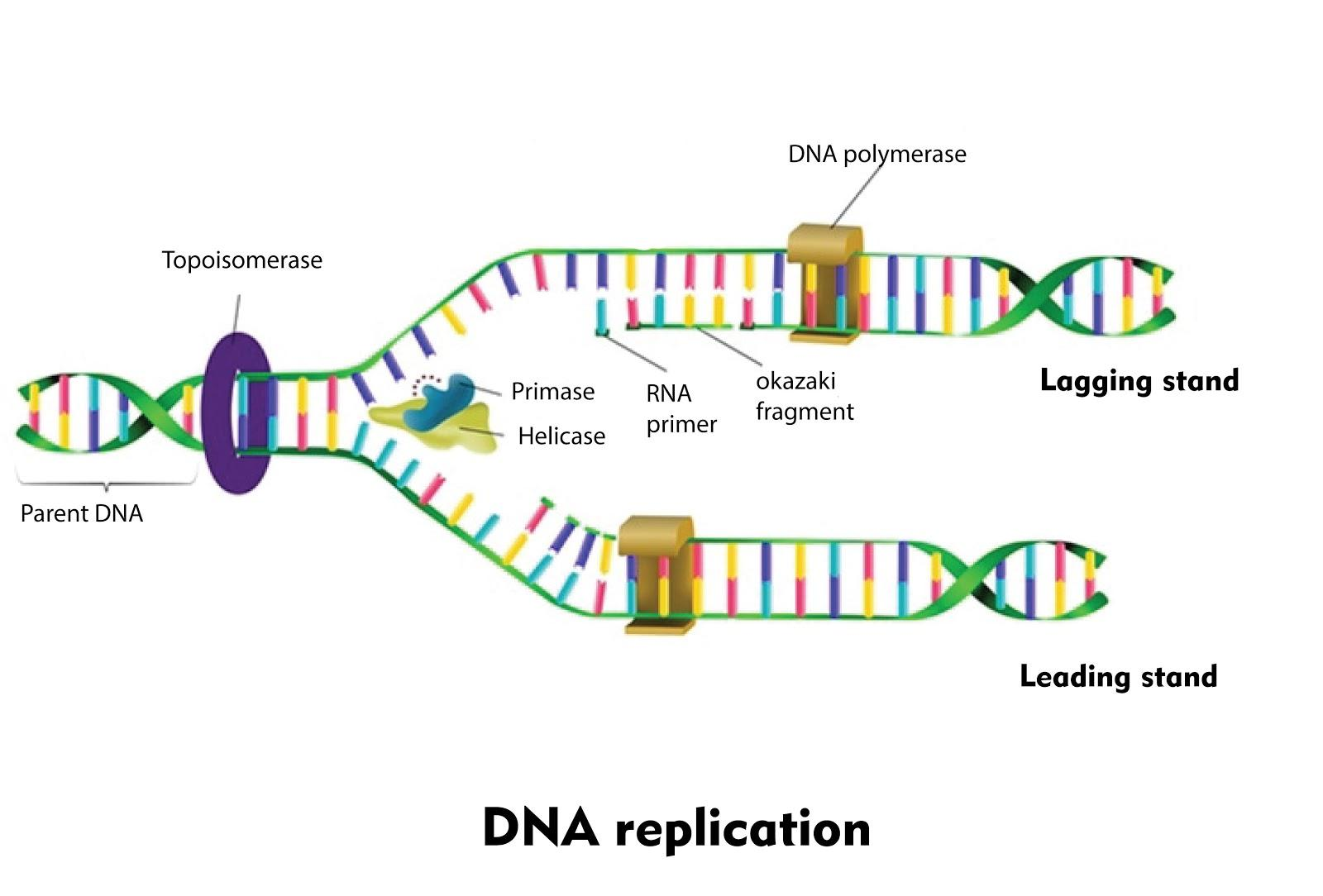
DNA helicase helps in
(a)Opening supercoils of DNA
(b)Making DNA helix
(c)Opening two chains of DNA helix
(d)Making Hydrogen Bonds of DNA helix
Answer
495.3k+ views
Hint: DNA helicase is the enzyme that unwinds the DNA double helix by breaking the hydrogen bonds down the centre of the strand. It begins at a site called the origin of replication, and it replicates the fork by separating the two sides of the parental DNA.
Complete answer:
Helicases move along the double-stranded DNA and separate the strands by breaking hydrogen bonds at the expense of energy from ATP. DNA unwinding by helicases creates topological stress/supercoils in the helical DNA structure which is relieved by the action of topoisomerases. These enzymes transiently break both DNA strands of one chromosome thereby making the other chromosome to pass through the break and relieve the stress. DNA polymerase enzyme synthesizes DNA strands by adding deoxyribonucleotides to the 3' end of the primer via phosphodiester bonds; it uses parental DNA as a template. Hydrogen bonding between base pairs is facilitated by the presence of hydrogen bond donor (primary and secondary amine groups or hydroxyl groups) and complementary hydrogen bond acceptor (carbonyls and tertiary amines) in bases; it is not an enzymatic process.
Additional Information:
During the reproduction process, the DNA copying (replication) mechanism is important as the copying of DNA helps to transfer the information or characters from parents to offspring. Copying DNA is also important as DNA (Deoxyribonucleic acid) is the genetic material found in the chromosomes that are present in a cell nucleus.
During reproduction, copying of DNA is necessary, because:
-DNA replication ensures that an equivalent amount of DNA is obtained by each daughter cell produced at the end of the cell division.
-If DNA is not replicated then the cells of the daughter will not obtain all the requisite genes.
-Essential proteins encoded by DNA can be missing if DNA is not replicated.
-Copying DNA can lead to recombination leading to evolution.
-Passing of genetic material from one generation to another triggers identical functions for the species.
-Demographic stability is maintained.
So, the correct answer is, ‘Opening two chains of DNA helix.’
Note: DNA determines the design of an individual's body. The DNA which is passed to offspring from parents makes them look identical. For reproduction the copying of DNA is important. During replication, additional DNA copies are made which are necessary for the new cells formed after cell division. Also, some minor changes during DNA replication are responsible for bringing long-term variations.

Complete answer:
Helicases move along the double-stranded DNA and separate the strands by breaking hydrogen bonds at the expense of energy from ATP. DNA unwinding by helicases creates topological stress/supercoils in the helical DNA structure which is relieved by the action of topoisomerases. These enzymes transiently break both DNA strands of one chromosome thereby making the other chromosome to pass through the break and relieve the stress. DNA polymerase enzyme synthesizes DNA strands by adding deoxyribonucleotides to the 3' end of the primer via phosphodiester bonds; it uses parental DNA as a template. Hydrogen bonding between base pairs is facilitated by the presence of hydrogen bond donor (primary and secondary amine groups or hydroxyl groups) and complementary hydrogen bond acceptor (carbonyls and tertiary amines) in bases; it is not an enzymatic process.
Additional Information:
During the reproduction process, the DNA copying (replication) mechanism is important as the copying of DNA helps to transfer the information or characters from parents to offspring. Copying DNA is also important as DNA (Deoxyribonucleic acid) is the genetic material found in the chromosomes that are present in a cell nucleus.
During reproduction, copying of DNA is necessary, because:
-DNA replication ensures that an equivalent amount of DNA is obtained by each daughter cell produced at the end of the cell division.
-If DNA is not replicated then the cells of the daughter will not obtain all the requisite genes.
-Essential proteins encoded by DNA can be missing if DNA is not replicated.
-Copying DNA can lead to recombination leading to evolution.
-Passing of genetic material from one generation to another triggers identical functions for the species.
-Demographic stability is maintained.
So, the correct answer is, ‘Opening two chains of DNA helix.’
Note: DNA determines the design of an individual's body. The DNA which is passed to offspring from parents makes them look identical. For reproduction the copying of DNA is important. During replication, additional DNA copies are made which are necessary for the new cells formed after cell division. Also, some minor changes during DNA replication are responsible for bringing long-term variations.

Latest Vedantu courses for you
Grade 11 Science PCM | CBSE | SCHOOL | English
CBSE (2025-26)
School Full course for CBSE students
₹41,848 per year
Recently Updated Pages
Master Class 12 Business Studies: Engaging Questions & Answers for Success

Master Class 12 English: Engaging Questions & Answers for Success

Master Class 12 Social Science: Engaging Questions & Answers for Success

Master Class 12 Chemistry: Engaging Questions & Answers for Success

Class 12 Question and Answer - Your Ultimate Solutions Guide

Master Class 11 Social Science: Engaging Questions & Answers for Success

Trending doubts
Draw a labelled sketch of the human eye class 12 physics CBSE

a Tabulate the differences in the characteristics of class 12 chemistry CBSE

Which one of the following is a true fish A Jellyfish class 12 biology CBSE

Why is the cell called the structural and functional class 12 biology CBSE

Differentiate between homogeneous and heterogeneous class 12 chemistry CBSE

Write the difference between solid liquid and gas class 12 chemistry CBSE




